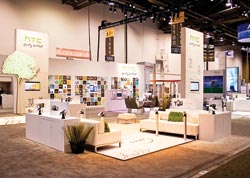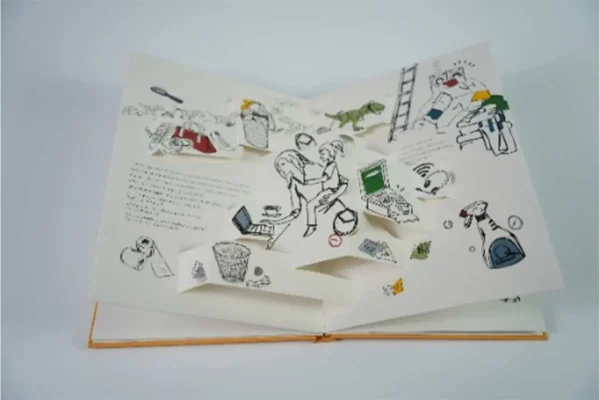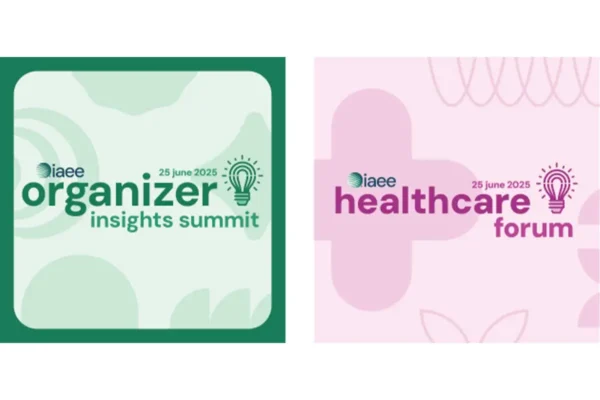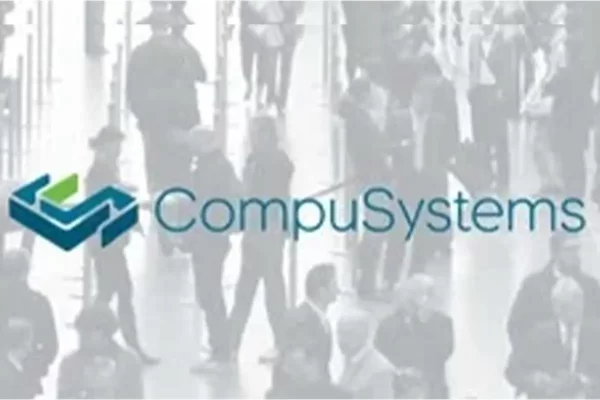
Photo by Jeff Hirouji
It seems that no segment of the exhibit industry has remained unscathed by the recent economic downturn, including exhibit graphic designers and production/print service providers.
“It’s super competitive in the graphics market,” said Michael Robertson, CEO and president of the Specialty Graphic Imaging Association (SGIA). “Commoditization has almost eliminated customer loyalty. The print quality bar is set higher than ever and margins are beyond tight. It used to be about price, quality and speed. Now, it’s all about price, price, price. If you are determined to follow the traditional business model, you should get hazardous duty pay because it will be ugly in the trenches.”
SGIA (SGIA.org) is an association for specialty imaging professionals who create graphics like exhibit signage, point-of-purchase displays and banners.

“Customers are asking for more today than ever in terms of turnaround times, pricing and service,” said Paul Lilienthal, president of Pictura Graphics of Minneapolis, Minn. “They want it yesterday with the same quality at a lower price. Faster, better, cheaper seems to be the new mantra. Unfortunately, the commoditization of our products and services is the tradeoff. Traditional value propositions have been very challenged in the ‘new economy.’”
Robertson said there are many ways for graphic producers to change their business model to promote growth in this economy, but servicing current customers should be first and foremost. He believes it is easier to sell additional services to an existing customer than it is to sell core services to the unknown. He also suggests that graphic printers provide continuing education opportunities for staff while also investing in the latest technologies for wide-format digital printing.
Troubling Trends
Other trends challenging graphic producers today include the deterioration of file-ready art and supply chain shortages.
“A troubling trend we are seeing at Pictura is that the caliber of the graphic design and file-ready art has been deteriorating over the last couple years,” Lilienthal said. “I believe this is happening because companies are laying off senior staff as a cost-cutting measure. There seems to be an expectation that customers can just dump whatever they have on us and expect us to throw magic pixie dust at it and it (the final graphic) will come out fantastic. We continue to find ourselves taking on more design responsibilities for clients without being able to recoup any revenue for our efforts.”
Lilienthal added that some of his exhibit house customers are guilty of this artistic gaff.
“There are some smaller exhibit house customers that get files from their customer and they forward the files on to us as-is,” he said. “We are essentially their file preparation group or art department.”
Lilienthal says he is also encountering supply chain shortages, out of stock, or discontinuations of materials with very little, or no, notification. He blames the shortages on the down economy. If he has a significant level of production requiring certain materials, or a client is specifying a hard to find material, the company gets a commitment from the customer to source more material than needed just in case a project requires more than originally anticipated.
Although flat panel monitors and digital-driven signage seem to be center stage these days, high-quality printed graphics are still in demand. Whether printed on a sheer fabric or a satin finish laminate, exhibitors have plenty of graphic options for getting their products or services noticed, their messaging across.
Ask the Professionals
Exhibit City News asked graphics professionals what positive trends they are seeing within the graphics segment of the exhibit industry.
“Green and environmental responsibility continues to be top of mind for some companies,” said Lilienthal. “We have been experiencing a significant increase in requests for ‘eco-friendly’ graphic alternatives. The bottom line is that sustainability makes common sense. Biodegradable is no longer enough. Therefore, we pay attention to material attributes, recyclability, production yield and waste when identifying solutions for our customers.
“Although not a new trend, fabric design continues to be popular because of its light weight. In terms of other materials, the recent economic conditions forced many companies to place product development on hold this last year. However, I do expect that to change in the second half of this year, as everyone will be trying to make up for lost time. Many of the new materials that we seek out are lower-cost alternatives that perform equal or better to current materials.Extension of graphic life is not always as large a consideration compared to quality, performance and appearance requirements.
“As you can expect, most (printing) processes that are significant upgrades or new technologies tend to recoup their R&D (research and development) investment from the early adopters, so they can tend to be more expensive.Technology continues to improve in terms of quality, but there are tradeoffs in terms of speed, colors, etc.”

Don Bennett, graphic manager at DisplayWorks in Irvine, Calif. (www.displayworks.com) began his career as a web and sheet fed pressman and advanced to oversee pressroom operations, spending 22 years managing a pre-press company. DisplayWorks specializes in custom exhibit design across a wide range of industries.
“A trend we are experiencing is higher demand for direct applied graphics. Where the norm used to be mounting the print to a substrate and attaching it to the exhibit with Velcro, we now print on adhesive vinyl or fabric and mount directly to the laminated panels. With this method, large murals or even individual graphics can be mounted to a variety of shapes, curves, arcs, etc., which allows our designers more creative flexibility. Floor graphics are also on the increase as clients are always looking for ways to visually stimulate and capture the attention of their audience.
“Producing graphics in this manner can help reduce manufacturing costs, but the real savings to the client is on the show floor since no additional time is required to install or dismantle these graphics. Shipping and drayage costs are also reduced, as you no longer need a crate specifically for these graphics.
“We produce our graphics on HPZ6100 and HP5500 inkjet printers. These printers provide some of the highest quality prints (up to 1200dpi) in the industry. These printers also allow excellent color matching so we can assure our clients’ look is consistent throughout the exhibit and show-to-show. With proper lamination, storage and handling, the graphics can easily last several years. Since the majority of tradeshow graphics are show-specific, this is usually not a requirement, but we also produce graphics for permanent installations so it was important to find the correct printers to solve both these needs.
“Graphically speaking, clients are consistently looking for ways to stop and engage their audience, so that initial connection can be made. Our design team is continually coming up with creative methods to achieve this by utilizing graphic elements such as murals, oversized or edge-lit backlit panels, dimensional or profile cut signage and fabric that help enhance the overall exhibit design.
“In the exhibit industry, it is important to remain flexible. Clients are continually waiting for the latest release, legal approval, or a specific image before they can finalize their graphics. It is critical that you look at all options and find a way to meet your clients needs.
Refuse to say ‘no’ and find a way to get the job done. With a strong team that understands this and by having procedures in place that streamline the production process, you can reduce the stress that is inherent in exhibit graphic production.”

Susan Coppola, tradeshow graphics division manager for Image Craft LLC (www.imcraft.com) in Phoenix, Ariz., is a photographer, printmaker and graphic artist and has been in the tradeshow graphics industry for more than 20 years.
“Inkjet processes, printers, inks, substrates, rips, color management, and even a technology-educated labor force have increased production capabilities. Today, we can do more, faster and better than ever before.
“One trend I am seeing is that ‘up’ is the new black. Companies that can are making vertical statements with their booth graphics. At EXHIBITOR2010 I felt like I was in an exhibit city of skyscrapers. Fabric graphics make this application easy and available to most exhibitors. I also saw grand-sized, seamless backlit fabric walls with LED lighting in the extruded frames. Hanging and lighted fabric seems to be a newer trend in the tradeshow and event industry.
“Another trend is that new print technologies are extending the life of a graphic. In February (2010), Image Craft installed an HPL65500 Latex Ink Printer. Latex ink technology offers a sharper, faster, cleaner, environmentally friendly way to print on fabrics. We have been experimenting with a flag cloth (semi-sheer) and a crease and wrinkle-resistant fabric and they both look fantastic. The color saturation and edge sharpness rivals dye sublimation. Because these products (fabrics) do not damage easily, they will last through many set ups. In addition, the latex inks are water based and odorless, they require no special ventilation and are green when printed to sustainable and recycle-able materials. The price point for latex printing to fabrics is less than dye sublimation and the process itself is green in comparison.
“Plan ahead, it’s not always possible, but give yourself and your vendors some breathing room when it comes to ordering and producing graphics. Build in time to see a physical test, it will guarantee you won’t be surprised. Carefully proofread all copy. There’s nothing worse than having a typo on your art in your booth when you’re at a show.”
Aleta Walther is a marketing communications professional and freelance writer with several years experience as a corporate exhibit manager. Contact Aleta at aw@waltherstewart.com.































